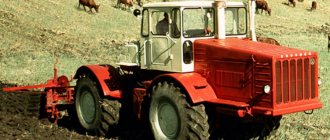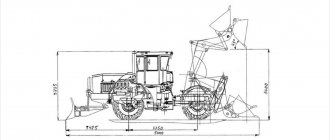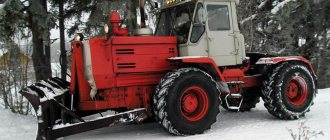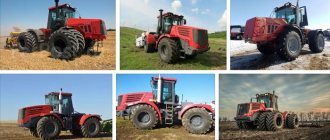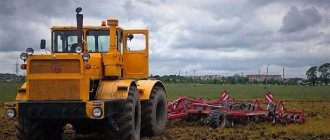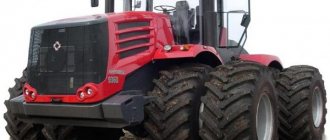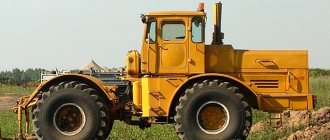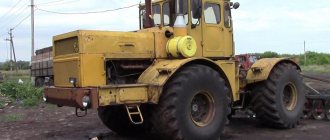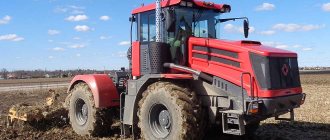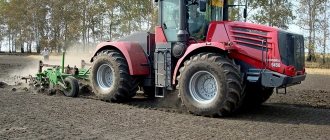In the early 1960s, the Soviet government set a task for agricultural workers: to bring the average annual grain harvest to 238-243 million tons. This was impossible without powerful tractors, and they immediately began to be produced. The Kirovets K-700 made a kind of revolution in large-scale farming, giving a powerful impetus to the development of this industry.
By the early 1990s, this powerful machine covered up to 40% of basic agricultural work. The K-700 was especially in demand in the grain-growing regions of Russia, Ukraine, and Kazakhstan. “Kirovets” also became famous for being the first Soviet tractor with rubber tires. Both our own experience and world practice said that such a tractor would be more convenient than a caterpillar tractor or one with metal wheels to move along highways at high speed under its own power, and would be easier to fit into the growing cargo flow.
Working in winter and summer, insensitive to Russian off-road conditions and quite comfortable, the Kirovets served for 20-30 years continuously on Soviet fields.
In the fall of 1959, N. S. Khrushchev, who was on a visit to the USA, was shown a powerful MV wheeled tractor from John Deere. The Head of the CPSU and the Soviet government not only appreciated it, but immediately upon his return, set the task of organizing production in the USSR on principle new energy-rich high-speed general purpose tractors with a capacity of 200-220 hp. with a wide train of mounted and trailed implements. Indeed, such cars were not produced in our country at that time, but they were needed.
History of the K-700
The Leningrad Kirov Plant was tasked with developing a new tractor in the shortest possible time and putting it into production. The company had extensive experience in tractor manufacturing: since 1924 it has produced the Fordson-Putilovets, and since 1934 the Universal. From 1924 to 1936, Kirov residents produced about 40 thousand machines that replaced the horse and plow. Conversion to heavy tanks during the Great Patriotic War contributed to the creation of a solid design and production-technological base, which was also quite suitable for tractors. A comprehensive reconstruction of the enterprise began. Many old buildings were demolished, and in their place huge buildings equipped with the latest equipment were erected. A 250 m long conveyor appeared in the tractor assembly building. A large forging and stamping shop, a welding shop, a tractor delivery shop, etc. were built.
At the end of 1961, the Kirov Plant began creating the most powerful tractor at that time - the K-700. In January 1962, a technical design was developed and approved, and in May working drawings of experimental K-700 tractors were prepared. The design of this machine and the production of its pilot batch were completed in an unprecedentedly short time. This became possible thanks to the highly qualified personnel of designers, engineers and workers, for which the plant has always been famous, since the time when it was called Putilovsky. Soon the enterprise began mass production of the powerful Kirovets K-700 wheeled tractors created by the team.
True and “wrong” ways to farm “Kirovets” K-700
“Kirovets” is a car that personified power and strength on the Soviet fields and continues to hold this title in the Russian open spaces. Big, square and yellow car - these three words were enough to describe this technique and understand what we were talking about. But over time, the approach to Kirovets has changed, and it can be described in one word - big, and as for other meanings, innovations have been added, such as “collective farm” and “acceptable”.
A way to farm Kirovets K-700. Preview for the video, which you can watch at the link below:
Watch video >>
There are enterprises that repair Kirov vehicles, but in addition to repairs, they make their own edits and improvements. For example, they deprive Kirovets of the very brutality that he had from birth. The heavy metal hood was replaced with a plastic one. Its weight made it easier to access the engine, and its shape made it possible to give the car a modern look.
This is how many recognize the legendary Kirovets
In addition to the hood, repair plants also made changes to the cabin - making them more comfortable and spacious, with doors that have vents rather than roll-down windows. The windshield was made solid and panoramic. But all these options are of a factory nature, and one way or another these improvements simplify work on Kirovets.
Kirovets from the repair plant - 1
Kirovets from repair plant -2
Kirovets from the repair plant - 3
But there are owners who did not like the factory innovations. As they say, “if you want something done well, do it yourself.” And people do as they want.
Here is Kirovets without a cabin at all. Management is carried out while standing. It is unclear what prompted this decision.
Kirovets “without a roof”
But the opposite solution is that the cabins of these Kirov vehicles have been increased significantly. This is understandable, when you work for a long time at Kirovets, the cabin begins to seem small and cramped. Why such a decision? Each tractor driver responds differently.
Kirovets with extended cabin – 1
Kirovets with extended cabin - 2
Kirovets with extended cab – 3
There are options when the increase in interior space is irreversible, which is called forever. You will only have to drive backwards. But you can get a good night's sleep. This cabin layout is acceptable for a bulldozer.
Kirovets bulldozer with a large cabin and sleeping bag
There are craftsmen who were able to connect two Kirovets using the “trick” of that same breaking frame. They simply took two halves with the cabins of two Kirov vehicles and connected them. Apparently one cabin was not enough.
Kirovets twin - the second part of which is also the front.
Many people are very surprised when they see a Kirovets with a truck cab. But such homemade products are not uncommon these days. And this experience, by the way, appealed to many tractor drivers.
Here is a Kirovets from the Baltic States, it was equipped with a cabin from Renault Magnum.
Kirovets from the Baltics with a cabin from Renault Magnum
This is a cabover long-haul tractor that was once popular.
Renault Magnum
Such a cabin on Kirovets looks like it’s a homemade Tonar.
This is what a Tonar truck looks like
With such dimensions, you can stand upright in the cabin. And the large glass area of this cabin gave rise to the nickname for the truck “aquarium”.
Two Kirovets in comparison
To make it comfortable to work on such a Kirovets in the field, it was necessary to cut a window in the rear of the cabin.
View window
Other Kirov owners decided to follow the experience of the masters from the Baltics. For some, the appearance of Soviet technology was transformed beyond recognition.
You won't know at all
And here is another version of the Kirov with a MAN cab. Unlike the Renault Magnum cabin, the MAN does not have a sleeping bag. Yes, and without it it looks quite nice. However, there is a drawback here - now you can’t throw the steering wheel back.
Kirovets with MAN cab
Kirovets with MAN cab
Kirovets with MAN cab
Take a look at the Kirov variants with cabs from DAF, Mercedes-Benz and Iveco trucks.
Kirovets with a cab from a Mercedes-Benz truck
Kirovets with cab from DAF truck
Kirovets with a cab from an Iveco truck
Which one do you like best? But don't rush to answer until you see this:
energy-rich Kirovets with a cabin from Volvo
energy-rich Kirovets with a cabin from Volvo
Energy-rich Kirovets with a cabin from Volvo. From the outside, this vehicle looks like a very large Volvo. If it were not for the wheels and yellow wings, it would be difficult to guess that there is a Kirovets here at all.
energy-rich Kirovets with a cabin from Volvo
But among the sensible alterations, there are also those called “reverse equivalent”. They take the Kirovets cabin and put it on a base that is hardly suitable for this. Here are some examples: On a tractor. On a van. On a truck. And even on a tank.
Kirovets cabin based on a tractor
Kirovets cabin based on a van
Kirovets cabin based on a truck
Kirovets cabin based on a tank
All these works that you saw could not have happened without the participation of Kirov residents. But what should those who don’t have a “free” Kirovets nearby do? There is only one answer - to create a copy of it, albeit a small one. But it will repeat the square shapes of the original. You can even go out into the field with this one.
Homemade Kirovets
Some may not like the fact that Kirov residents are always yellow. What if there is a zombie apocalypse, and you have to work in extremely difficult conditions, what then? And there is also an answer to this question - the unkillable Kirovets-Sibiryak!
This Kirovets is for a “special” occasion.
Testing a new tractor
Straight from the assembly line, the first Kirovets went to the fields of a suburban state farm for pre-factory debugging tests in the field. A huge, powerful machine, dragging an eight-furrow plow, laid the first furrow 25-27 cm deep. The tractor moved at an unprecedented speed, turning over huge layers of earth. Soon the first one was joined by two more Kirovets. A practical test confirmed the main technical indicators included in the project. In March 1963, seven more vehicles were sent for state testing.
Now the conditions have become more difficult: in Kazakhstan, during cotton sowing, in Azerbaijan, on difficult-to-cultivate soil, in Rostov-on-Don. In 1963, 50 K-700 tractors were manufactured. Soon the plant began mass production of Kirovets. By the end of 1964, there were already 1,200 vehicles in service. In 1966, production increased to 3820 tractors and increased from year to year. In 1975, the 100,000th Kirovets rolled off the assembly line of the Kirov plant. Each subsequent five-year period was marked by another hundred-thousandth anniversary: 1980 - the 200,000th tractor, 1985 - the 300,000th tractor. In 1987, a record was reached - 23,003 tractors. There were no analogues in world practice.
These machines helped not only raise large-scale agriculture to a higher level, but were also effectively used in the mining and gold mining industries, in land reclamation and irrigation work, and in large new buildings.
25 years ahead
In 1968, the K-700 tractor received a gold medal at an exhibition of agricultural machines in Germany, and in 1969 it was recognized as the world's most powerful agricultural wheeled tractor at the 40th Paris Salon-Exhibition of Tractors and Agricultural Machines. Indeed, the power, labor productivity, reliability, ease of operation and repair of the Kirovets met the world requirements of that time. Moreover, experts claim that this machine is at least 25-30 years ahead of its European counterparts.
The tractor frame consists of front and rear articulated semi-frames. The front frame is equipped with a water-cooled engine, an oil system (engine oil cooler and gearbox), air filters and an engine pre-heating system, as well as a pedestal, cabin, fuel tank and cladding parts. The front axle is attached to the bottom. A linkage mechanism with lifting hydraulic cylinders, a coupling and a single-speed power take-off shaft gearbox are installed on the rear semi-frame of the tractor. The rear axle is attached to the rear semi-frame from below using stepladders.
The K-700 tractor is equipped with a four-stroke eight-cylinder diesel engine YaMZ-238NB with a power of 220 hp. with a turbocharger and a two-stage air purification system. The engine cylinders are cast together with the upper part of the crankcase and are arranged in two rows in the form of a Latin letter V with a camber angle of 90°. This arrangement is due to the desire to reduce the length of the engine, which contributes to a more rational layout and a reduction in its overall weight. The reciprocating motion of the pistons is transmitted to the crankshaft mounted in a block on five supports. Each cylinder has a gas distribution system with two valves: intake and exhaust. Air is supplied to the cylinders by a turbocharger under excess pressure. As a result of turbocharging, an increased dose of fuel is burned, and, consequently, engine power increases. The thick-walled piston crown houses an open toroidal combustion chamber that provides maximum air swirl.
The K-700 tractor does not have a clutch. Instead there is a drain pedal (pressure drop in the gearbox hydraulic system). The gearbox is mechanical, with constant mesh gears, hydraulically controlled four clutches and mechanically controlled gear clutches. All gears are straight-cut. Number of gears (hydraulic) - 4 (plus 2 neutral), 4 modes (mechanical), high-low switching. As a result, the number of speeds is 16 and, accordingly, 8 rear. The box is designed to change gears without loss of power (due to friction clutches). Modes are switched by moving gears, as in any manual transmission. The speeds change when the spool is switched (by redirecting the hydraulic oil flow), the 2nd neutral turns off the hydraulic flow, the 1st neutral, in addition to turning off the hydraulic flow, mechanically brakes the drive shaft (shaft with clutches) in the gearbox, like a hand brake.
Thus, a gearbox with 16 speeds in 4 ranges, 2 drive axles, a mechanical transmission, and hydraulic control of switching within modes ensured the efficiency of technological, working and transport modes. The hydraulic turning system and articulated frame optimized the layout and increased the maneuverability and maneuverability of the tractor. New traction qualities (5 tons on a hook) and a speed of up to 10 km/h when plowing increased labor productivity in agricultural and transport operations by 2-3 times and reduced the agrotechnical time required for agricultural work by 2 times.
Characteristics of K-700
The K-700 is huge and wide, and yet its main feature is not its size, but its double frame: front and rear. Almost everything is installed at the front: the cabin, gearbox, front axle, engine and two fuel tanks integrated into the wings, with a total fuel volume of 320 liters (there is also an oil tank). The rear frame is not so monumental - another bridge and built-in equipment. All attachments that can be hung on the Kirovets are hung backwards.
Tractor "Kirovets" K-700 in the photo
Another feature of Kirovets is the absence of springs.
The frames are connected to each other by a hinge mechanism. It is also unique: can you imagine the load it bears, how many tons it can withstand? Even if you put skis on the back, it will go, since all the most important things are located in the head part of the tractor. And the main thing in this design is not even the engine, but the gearbox, from a design point of view, a very advanced elegant thing, albeit huge in size.
Gearbox K-700
The tractor does not have a clutch. Instead, there is a drain pedal - pressure drop in the hydraulic system. The gearbox is mechanical, 16-speed, has 4 modes, with hydraulic control, four clutches and mechanical control with gear clutches. To control the gearbox, two levers are used: the first lever turns on the speeds: work, transport, reverse; and the second lever switches modes: 1st, 2nd, 3rd and 4th.
Gearbox K-700 in the photo
A special feature of the K-700 gearbox is that it is designed to change gears without loss of power due to clutches. Why not a tank?
Everything here is hydraulically and vacuum thought out. Not only can you brake with a gearbox, there are also very good vacuum brakes - 13 tons slow down predictably and understandably, and you don’t feel the mass at all.
Engine K-700
The K-700 engine is huge, like a tank, the YaMZ 240 is a diesel V12. The working volume is more than 22 liters, the maximum possible power is 360 horsepower; 1900 rpm, maximum torque - 1240 newton meters.
Kirovets K-700 tractor engine in the photo
The cylinder block of the K-700 engine is cast iron, the number of working strokes is 4; fuel is supplied to the intake system under high pressure. This engine weighs as much as 1700 kg.
Cabin
To get, or rather, climb into the cabin, you will have to make some effort. They say about the K-700 cabin “you sit like on a Russian stove, but feel free like in an apartment.”
Cabin K-700 in the photo
The instruments are grouped on the dashboard on the left: oil pressure, system pressure, engine hours, airflow, wipers - the impression is that you are sitting in the passenger compartment of a car. The driver's seat has adjustable springs. The steering column is also adjustable.
Do you know why the driver's seat on agricultural machinery is always located on the right? Everything is very simple: the plowed field is on the right, and it is more convenient for the driver to monitor the arable land.
Working conditions of the K-700 tractor driver
The designers paid special attention to the working conditions of the tractor driver. The tractor cabin was made all-metal, sealed, equipped with a ventilation and heating system and sprung seats. In addition, there was a first aid kit, rear-view mirrors, windshield wipers, sun visors, interior lighting, turn signal lights, side lights and brake lights. A box for a tank with drinking water was welded to the rear wall of the cabin, and a panel with control instruments, toggle switches and signal lamps was installed on the front wall. All basic operations for assembling a tractor with various implements could be performed by the tractor driver himself.
Models created on the basis of the K-700 tractor
In 1975, the Kirov Plant began serial production of the K-700A tractors with an 8-cylinder YaMZ-238NDZ engine (235 hp) and K-701 with a 12-cylinder YaMZ-240BM2 engine (300 hp). The only difference between these models was the engine, but both were very different from the base K-700. So, they had different wheels (not unified with the wheels of the K-700 tractor), not one, but two fuel tanks (side), which merged into a single unit with the front wings of the tractor, there were no springs. This option began to be used in other sectors of the national economy of the USSR. For installation on the rear semi-frame of the K-700A and K-701 tractors, various equipment was developed: loading P-4, P-4/85, stacking, etc.
On the basis of the next model, K-703, with a reversible control post, the LT-163 timber stacker (after the LT-195 modernization), the ML-56 timber skidding machine, the LB-30 gradedozer, the PF-1 front-end loader, and the DM- universal road machine were created. 15, etc. To perform reclamation and other work, a trencher was developed on the basis of the Kirovets tractor.
Seeing the great demand for the Kirovets in other sectors of the national economy, the Kirov Plant produced a wide variety of equipment based on this tractor model: tractors, bulldozers, loaders, vibratory rollers, snow blowers, mobile welding units, etc. Demand for K-700 series machines and its modernization does not decrease to this day.
Subscribe to our Telegram channel
Technical characteristics of Kirovets K-700A
The K-700A tractor is one of the first modifications of domestic wheeled energy-rich agricultural tractors. Many years of experience in operating these machines in various climatic zones confirms their high reliability, simplicity and ease of maintenance, and efficiency in all types of agricultural work on a par with the MTZ 82 tractor.
Photo of the Kirovets K 700A tractor
The K 700A tractor is a modernized model of the K 700 tractor. It also served as the base model for the creation of the K 701 and K 702 tractors. The main difference between the K 700A tractor and the K 700 tractor is as follows:
- Possibility of installing the YaMZ-2E8NB and YaMZ-240B engines by strengthening the front half-frame in the hinge support area.
- The base and track of the tractor have been increased.
- The seats in both the front and rear links of the rear semi-frame have been modernized to allow the installation of additional equipment.
- Rigid fastening of the front and rear axles has been developed.
- To improve the traction qualities of the tractor and increase the load-bearing capacity, radial tires were installed.
- The location, number and capacity of tanks have changed.
The K-700A tractor uses a YaMZ-238ND diesel engine. Which does not exclude the use of the SCH-6 seeder
The K-700A tractor is equipped with a manual gearbox with constant mesh gears and friction clutches for gear shifting with a hydraulic drive, ensuring shifting without interrupting the power flow.
A double, sealed, heat and noise insulated cabin with a good heating and ventilation system provides comfortable working conditions for the driver.
The additional equipment of the tractor includes: a power take-off mechanism, reverse control, and a wheel doubling kit. These and other advantages allow it to be used in conjunction with the Don 1500 combine.
| Engine power, kW (hp) | 169 (230) |
| Specific fuel consumption, g/kWh | 252 |
| Travel speed, km/h | 2,6 -33,8 |
| Number of gears: | |
| forward | 16 |
| back | 8 |
| Load capacity of three-point hitch, kN | 56,0 |
| Travel of the suspension axis of the mounted device, mm | 1175 |
| Overall dimensions, mm: | |
| length | 6820 |
| width | 2850 |
| height | 3685 |
| Mass, t. | 12,8 |
